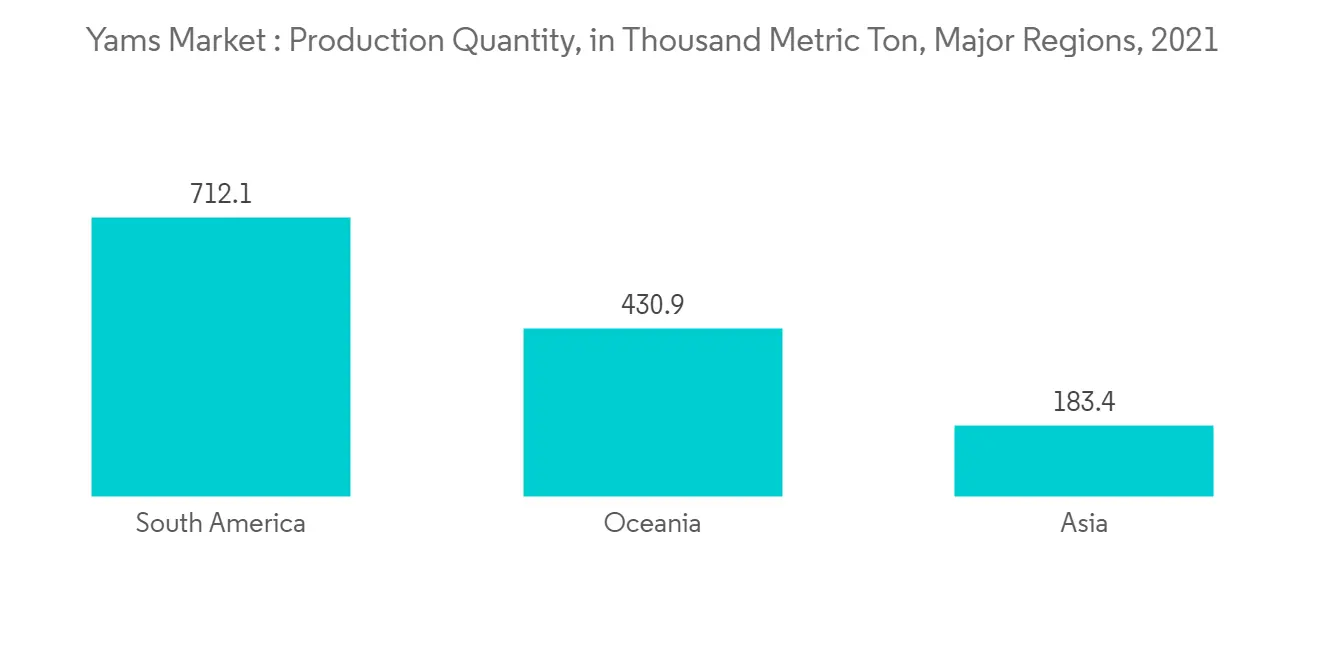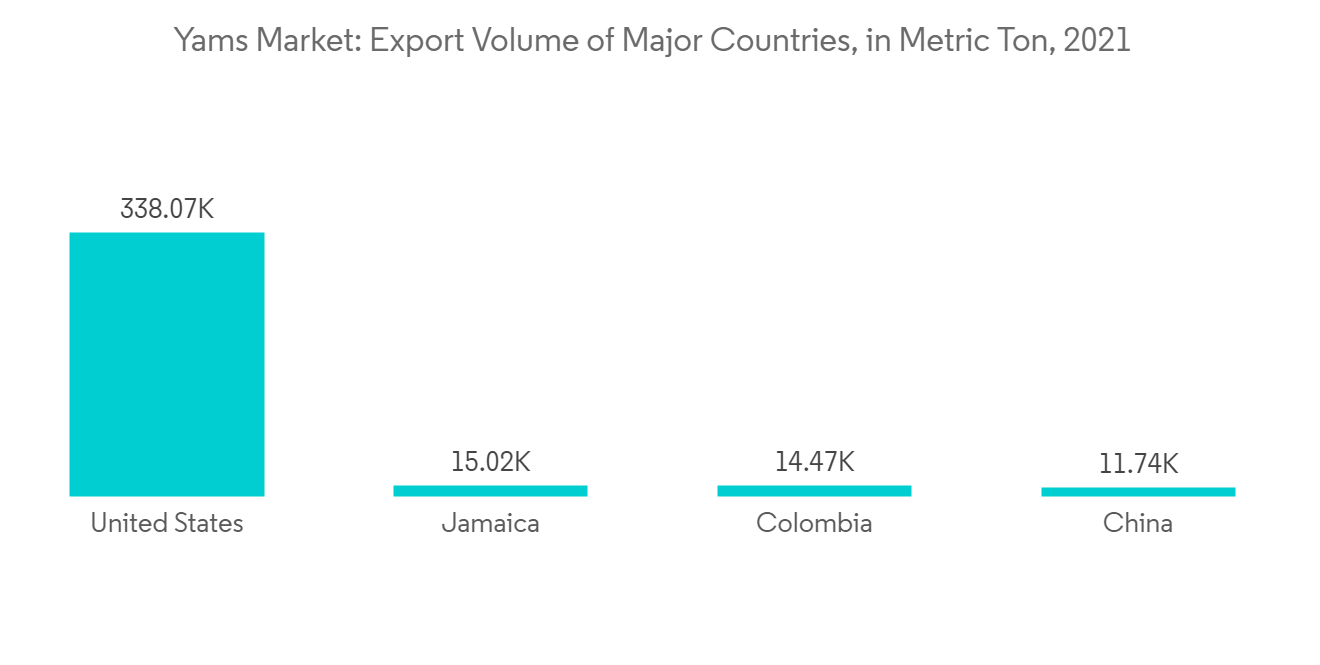 |
市場調査レポート
商品コード
1273534
ヤムイモ市場- 成長、動向、予測(2023年~2028年)Yams Market - Growth, Trends, and Forecasts (2023 - 2028) |
||||||
● お客様のご希望に応じて、既存データの加工や未掲載情報(例:国別セグメント)の追加などの対応が可能です。 詳細はお問い合わせください。
価格
| ヤムイモ市場- 成長、動向、予測(2023年~2028年) |
|
出版日: 2023年04月14日
発行: Mordor Intelligence
ページ情報: 英文 120 Pages
納期: 2~3営業日
|
ご注意事項 :
本レポートは最新情報反映のため適宜更新し、内容構成変更を行う場合があります。ご検討の際はお問い合わせください。
- 全表示
- 概要
- 目次
概要
ヤムズ市場は予測期間中に3.5%のCAGRで推移すると予測されます。
主なハイライト
- ヤムイモは、アフリカ、米国、カリブ海、南太平洋、アジアで栽培される一年草や多年草のつる性植物が作る大きな塊茎の形をしたでんぷん質の主食です。ホワイトギニアヤム(D. rotundata)は、西部および中央アフリカで最も重要な種です。ウォーターヤム(D. alata)は、アジアが原産で、世界で最も広く分布している種で、2番目に栽培されています。消費者のヤムイモに対する需要は世界的に非常に高く、ヤムイモの栽培は高い生産コストにもかかわらず採算が取れています。ヤムイモの加工業者は、高品質の塊茎の安定供給がなければ、新たな加工能力への投資に消極的です。
- ヤムイモの健康効果に対する消費者の意識の高まりは、世界の需要を増加させています。山芋は栄養価が高く、ビタミンC、マグネシウム、カリウム、マンガン、銅、食物繊維を含んでいます。また、山芋は脳機能の向上や関節炎の症状を和らげる効果もあります。山芋にはジオスゲニンというユニークな化合物が含まれており、神経細胞の成長を促進し、脳機能を高め、骨粗鬆症や関節リウマチの進行を抑制する効果があります。また、山芋はコレステロール値を維持する働きもあります。
- ヤムイモの塊茎は約21%の食物繊維を含み、炭水化物、ビタミンC、必須ミネラルを豊富に含んでいます。世界のヤムイモの年間消費量は1,800万トンで、2021年には西アフリカで1,500万トンとなります。西アフリカでの年間消費量は、2021年時点で一人当たり61キログラムです。ヤムイモは、煮たり、焼いたり、揚げたりして食べます。アフリカでは、茹でた後に潰して粘りのあるペーストや生地にすることもあります。
ヤムイモの市場動向
世界のヤムイモの健康効果の高まり
- ヤマイモは、食物繊維、タンパク質、ビタミン、ミネラル、マグネシウム、カリウム、銅、葉酸、チアミンなどを豊富に含む塊根野菜で、骨の健康、成長、代謝、心臓機能のサポートに重要です。
- ヤマイモにはジオスゲニンというユニークな化合物が含まれており、神経細胞の成長を促進し、脳機能を高めることが分かっています。さらに、ホルモンバランスを改善し、女性の更年期障害、PMS、不妊症、性欲減退を治療する効果があり、世界中で山芋の生産量が増加しているため、山芋の市場需要を促進することになります。
- ヤムイモは、前シーズンから保存した塊茎の一部や小さな塊茎全体(「シードヤム」)を植えることで栽培されます。生産者の大半を占める小規模農家では、ヤムイモを穀物や野菜と混作することが多いです。
- 土壌肥沃度の低下、害虫の増加、人件費の高騰などにより、一部の伝統的な産地ではヤムイモの生産が減少しています。このような農業文化を根絶するため、生産者は精密農業や総合的害虫管理(IPM)技術を導入し、地域の作物生産性を安定させようとしています。
- FAO(国連食糧農業機関)によると、アフリカ地域のナイジェリアやガーナなどの国々は、11,000年前にヤムイモの栽培が始まり、同地域の主要な商品の一つであることから、生産量に大きなシェアを占めています。また、ベナン、カメルーン、中央アフリカ共和国、コートジボワール、チャド、エチオピアは、世界の主要なヤムイモの生産国のひとつです。
- 国際熱帯農業研究所(IITA)によると、世界の生産量のほとんどは西アフリカで、94%を占めており、2021年にはナイジェリアだけで71%を生産しています。

ヤムイモの輸出動向の上昇
- ITC Trademapによると、2021年には、ガーナ、米国、ジャマイカ、コロンビア、中国、コスタリカ、インドが世界の主要なヤマイモ輸出国となり、447,6200メートルトン、1億9,917万9,000米ドルを占めると予想されます。
- ヤムイモの塊茎は約21%の食物繊維を含み、炭水化物、ビタミンC、必須ミネラルを豊富に含んでいます。アフリカ産のヤムイモのほとんどは国内で消費され、全世界で1,800万トンのうち1,500万トンを占めています。
- ヤムイモの輸出は、ガーナが24.4%と大きなシェアを占めており、米国(20.1%)、ジャマイカ(11.0%)がそれに続く。2019年のガーナ輸出振興局によると、ガーナからのヤムイモの主な輸出先は英国で557万6,000米ドル、次いで米国で322万5,000米ドルとなっています。これらの市場を合わせると、2019年のガーナの総輸出額27,282トンの69.2%を占めています。世界的にヤムイモの需要が高まっていることから、輸出機会の拡大が期待されます。

その他の特典:
- エクセル形式の市場予測(ME)シート
- 3ヶ月間のアナリストサポート
目次
第1章 イントロダクション
- 調査の前提条件と市場定義
- 本調査範囲
第2章 調査手法
第3章 エグゼクティブサマリー
第4章 市場力学
- 市場概要
- 市場促進要因
- 市場抑制要因
- バリューチェーン分析
第5章 市場セグメンテーション
- 地域別
- 北米
- 米国
- カナダ
- メキシコ
- その他北米地域
- 欧州
- ドイツ
- 英国
- フランス
- ロシア
- スペイン
- その他欧州
- アジア太平洋地域
- インド
- 中国
- 日本
- その他アジア太平洋地域
- 南米
- ブラジル
- アルゼンチン
- その他南米地域
- 中東・アフリカ地域
- ナイジェリア
- ガーナ
- その他中東とアフリカ
- 北米
第6章 市場機会と将来動向
目次
Product Code: 70134
The Yams market is projected to register a CAGR of 3.5% over the forecast period.
Key Highlights
- Yams are starchy staples in the form of large tubers produced by annual and perennial vines grown in Africa, the United States, the Caribbean, South Pacific, and Asia. White Guinea yam, D. rotundata, is the most critical species in western and Central Africa. Water yam, D. alata, the second most cultivated species, originated from Asia and is the most widely distributed species in the world. Consumers' demand for yam is generally very high globally, and yam cultivation is profitable despite high production costs. Yam processors are reluctant to invest in new processing capacity without a steady supply of high-quality tubers.
- The increasing awareness among consumers of yams' health benefits increases global demand. Yams are nutrient-rich and contain vitamin C, magnesium, potassium, manganese, copper, and fiber. Yams also help in improving brain functions and relieving arthritis symptoms. They contain a unique compound called diosgenin, which promotes neuron growth, enhances brain function, and inhibits the progression of both osteoporosis arthritis and rheumatoid arthritis. Yams also help to maintain cholesterol levels.
- Yam tubers comprise about 21% dietary fiber and are rich in carbohydrates, vitamin C, and essential minerals. Worldwide annual consumption of yams is 18 million tons, with 15 million in West Africa in 2021. Annual consumption in West Africa is 61 kilograms per capita in the year 2021. Yams are boiled, roasted, baked, or fried. In Africa, they are also mashed into a sticky paste or dough after boiling.
Yams Market Trends
Rising Health Benefits of Yams across the Globe
- Yams are a kind of tuber vegetable rich in fiber, protein, vitamins, minerals, magnesium, potassium, copper, folate, and thiamine which are important for supporting bone health, growth, metabolism, and heart function.
- Yams contain a unique compound called diosgenin, which has been found to promote neuron growth and enhance brain function. Additionally, it improves hormonal balance to treat menopause, PMS, infertility, and low libido in females, owing to greater yams production across the globe, which will propel the demand for yams in the market.
- Yams are grown by planting pieces of tuber or small whole tubers ('seed yams') saved from the previous season. Small-scale farmers, the majority of producers, often intercrop yams with cereals and vegetables.
- Due to declining soil fertility, increasing pest pressures, and the high cost of labor, yam production is declining in some of the traditional producing regions. To eradicate this farming culture, the growers are modulating precision agricultural and integrated pest management (IPM) techniques to stabilize crop productivity in the regions.
- According to the Food and Agricultural Organization (FAO), countries like Nigeria and Ghana of the African region holds a significant share in the production as yam cultivation started 11,000 years ago and is one of the primary commodity in the region. Benin, Cameroon, Central African Republic, Cote d'Ivoire, Chad, and Ethiopia, are some of the major producers of yam in the world.
- According to the International Institute of Tropical Agriculture (IITA), most of the world's production comes from West Africa, representing 94%, with Nigeria alone producing 71% in 2021.

Rising Export Trend for Yams
- According to the ITC Trademap, in 2021, Ghana, the United States, Jamaica, Colombia, China, Costa Rica, and India were the major yam exporters globally, accounting for 447,6200 metric tons valued at USD 199,179 thousand.
- Yam tubers comprise about 21% dietary fiber and are rich in carbohydrates, vitamin C, and essential minerals. Most of the African yam produced is consumed domestically, accounting for 15 million tons out of 18 million tons worldwide.
- Ghana accounts for a major share of 24.4% export of yam, followed by the United States (20.1%) and Jamaica (11.0%). According to the Ghana Export Promotion Authority in 2019, the United Kingdom was the main export destination for yams from Ghana valued at USD 5,576 thousand, closely followed by the United States with USD 3,225 thousand. Together, these markets comprise 69.2% of the total Ghanaian export value, 27,282 metric tons in 2019. The increased demand for yams globally is expected to increase the export opportunity.

Additional Benefits:
- The market estimate (ME) sheet in Excel format
- 3 months of analyst support
TABLE OF CONTENTS
1 INTRODUCTION
- 1.1 Study Assumptions & Market Definition
- 1.2 Scope of the Study
2 RESEARCH METHODOLOGY
3 EXECUTIVE SUMMARY
4 MARKET DYNAMICS
- 4.1 Market Overview
- 4.2 Market Drivers
- 4.3 Market Restraints
- 4.4 Value Chain Analysis
5 MARKET SEGMENTATION (Production Analysis in Volume, Consumption Analysis by Volume and Value, Import Analysis by Value and Volume, Export Analysis by Value and Volume, and Price Trend Analysis)
- 5.1 Geography
- 5.1.1 North America
- 5.1.1.1 United States
- 5.1.1.2 Canada
- 5.1.1.3 Mexico
- 5.1.1.4 Rest of North America
- 5.1.2 Europe
- 5.1.2.1 Germany
- 5.1.2.2 United Kingdom
- 5.1.2.3 France
- 5.1.2.4 Russia
- 5.1.2.5 Spain
- 5.1.2.6 Rest of Europe
- 5.1.3 Asia Pacific
- 5.1.3.1 India
- 5.1.3.2 China
- 5.1.3.3 Japan
- 5.1.3.4 Rest of Asia Pacific
- 5.1.4 South America
- 5.1.4.1 Brazil
- 5.1.4.2 Argentina
- 5.1.4.3 Rest of South America
- 5.1.5 Middle East and Africa
- 5.1.5.1 Nigeria
- 5.1.5.2 Ghana
- 5.1.5.3 Rest of Middle East and Africa
- 5.1.1 North America
6 MARKET OPPORTUNITIES AND FUTURE TRENDS
お電話でのお問い合わせ
044-952-0102
( 土日・祝日を除く )
